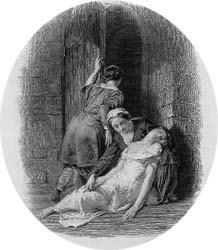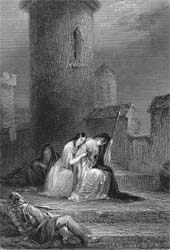|
|
Home | Corson Collection | Biography | Works | Image Collection | Recent Publications | Portraits | Correspondence | Forthcoming Events | Links | E-Texts | Contact The Betrothed (Tales of the Crusaders)First Edition, First Impression: Tales of the Crusaders. By the Author of "Waverley", "Quentin Durward", &c. In Four Volumes. Vol. I (II-IV). Edinburgh: Printed for Archibald Constable and Co. Edinburgh; And Hurst, Robinson and Co., London, 1825. Composition | Synopsis | Reception | Links Composition
SynopsisThe plot unfolds against the backdrop of border conflicts between the Anglo-Norman and Welsh barons. Having refused the hand of his daughter, Eveline, to the Welsh prince Gwenwyn, the Anglo-Norman Raymond Berenger is killed when the incensed Gwenwyn lays siege to his castle of Garde Douloureuse. His daughter is saved only by the intervention of Hugo de Lacy, Constable of Chester who, in turn, slays Gwenwyn. Out of gratitude rather than love, Eveline pledges herself to her elderly rescuer. Hugo, though, must fulfil a vow to join the Third Crusade and sets out immediately leaving Eveline under the guardianship of his nephew and heir Damian. Though both struggle against their feelings, an unconfessed love develops between the two youngsters during Hugo's three-year absence. When Damian is wounded defending Eveline from abduction, she takes him into her castle and nurses him. Although the couple remain chaste, malicious rumours are circulated concerning the nature of their relationship, and the King is moved to act against them. A royal force takes Garde Douloureuse, Damian is arrested, and Eveline's estates are declared forfeited. When Hugo returns from the Crusades he finds that the couple have been charged with high treason and with profiting from his absence to indulge their illicit love. Hugo is able to prove that the charges against Eveline and Damian are groundless, releases Eveline from her vow, and grants her permission to marry Damian.
ReceptionDespite Scott's pessimism, The Betrothed was favourably received by both critics and public, and considered a worthy companion to The Talisman. The Monthly Review, however, thought it a 'dull tale', and the Edinburgh Magazine felt that it was heavy-going and clumsily constructed in parts. Posterity has been less kind. One biographer of Scott, Hesketh Pearson, wrote: "The Betrothed was clearly composed in a somnolent if not stertorous condition, and would score high marks in a competition to decide which was the dreariest and stupidest book ever produced by a writer of genius." (Walter Scott: His Life and Personality, p. 54) Links
Last updated: 19-Dec-2011 |
|||


